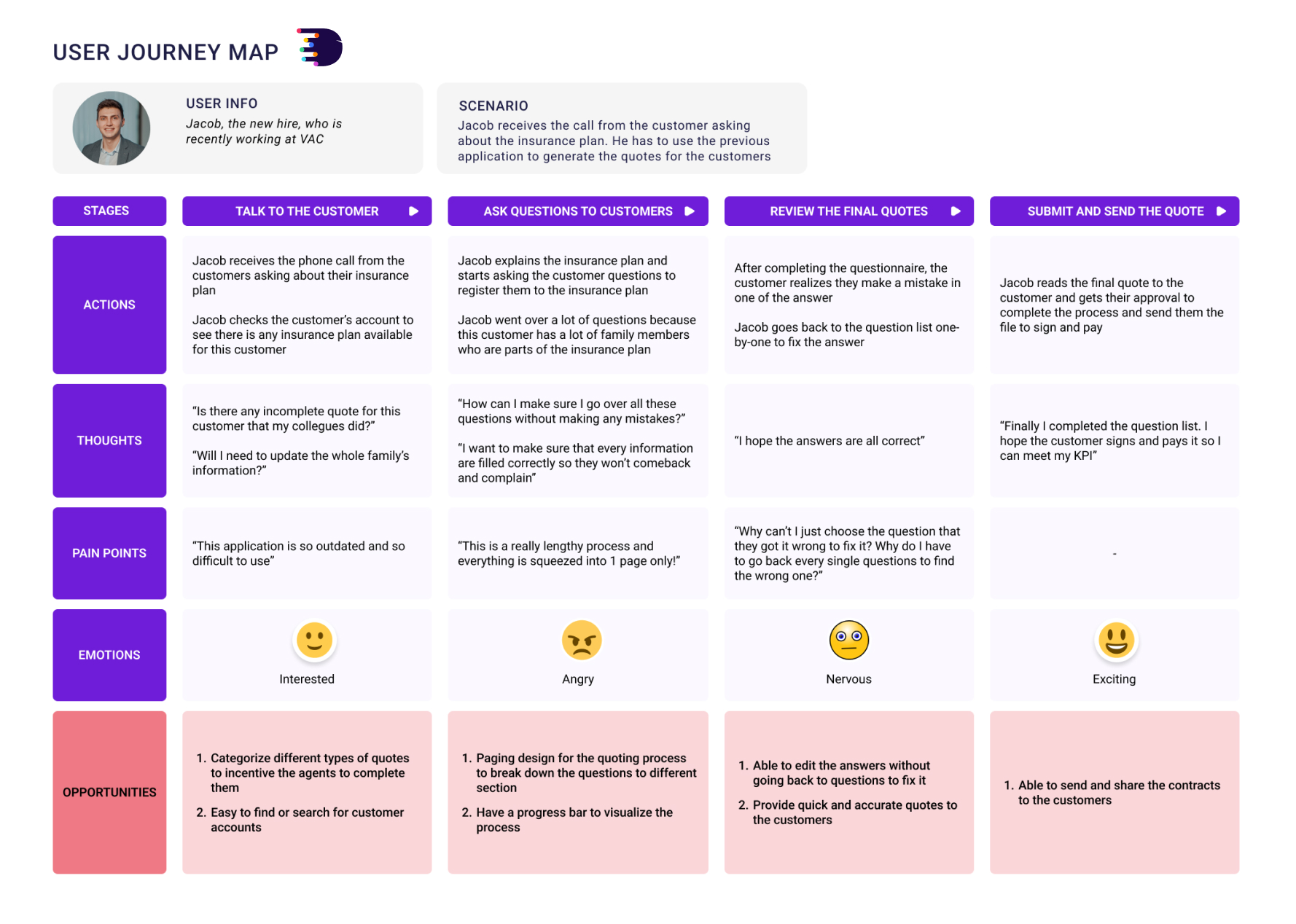















UI & UX Case Study
Mobile experiences built for insurance agents
to take the complexity out of assisting clients
buying insurance

Vanguard Assurance Corporation (VAC) is a hypothetical US-based insurance provider specializing in car insurance services. VAC encountered significant operational challenges that necessitated a comprehensive overhaul.
Foremost among these challenges was an outdated mainframe software system, which proved inflexible and resistant to updates. This hindered independent agents from effectively utilizing VAC's software, resulting in notable business losses. Despite attempts to modernize the software, complications arose, exacerbating the existing issues.
My role centered on a user-centric design methodology at Vanguard Assurance Corporation (VAC). I conducted in-depth interviews with insurance agents to understand their needs and challenges, which formed the basis for problem definition.I then engaged in ideation, prototyping, and testing phases, using feedback to iteratively refine designs.
The primary aim of this project was to create a user-friendly, flexible, and scalable platform that would empower insurance managers to access reliable and precise quotes while providing robust support to agents. To achieve this overarching objective, I established the following design goals:
Enable the creation of accurate, modifiable, and searchable quotes
Our primary objective is to revolutionize the way quotes are generated. We aim to provide agents with a platform that allows for the creation of precise and customizable quotes.

Trained agents on best industry practices and encourages leads
Equipping agents with industry knowledge and fostering lead generation is another pivotal goal. We're committed to creating a platform that not only streamlines the quoting process but also serves as an educational tool.
Figma was the primary tool I used for designing and prototyping and relied heavily on user research to uncover user pain points, behaviour, and needs. Then I continued to further refine my design concept using Miro
The catalyst for reorienting business priorities predominantly stems from insights gathered from frontline insurance agents. When engaged in direct conversations about their key objectives, these agents consistently emphasize the importance of delivering proposals to clients with minimal delay.
However, it's worth noting that the administrative bottlenecks which inhibit streamlined, straight-through processing also serve as obstacles that compromise these agents' ability to rapidly produce proposals. This internal friction reveals a systemic issue that needs to be addressed for both operational efficiency and customer satisfaction.
“Omnichannel communication and transparency are two reasons. Most insurers
allow customers to open a claim on a website or app. According to our survey,
drives satisfaction rates more than anything else: speed of settlement. The
longer it takes to settle a claim, the less satisfied that policyholder will be.”
Darcy Dague, Accenture Managing Director - Insurance
I created the following persona based on my experience interviewing parents during our initial research phase.


Throughout this project, I remained acutely aware of the challenges posed by the need for compatibility with legacy systems.
One significant constraint arose from the sheer volume of private information involved. It was imperative to ensure a seamless transition for agents, particularly senior agents, as this transition required not only a redesign of the front-end to minimize disruptions and confusion but also substantial adjustments on the back-end to facilitate the proper migration of data.
Offering a modernized and user-friendly mobile platform for independent insurance agents to streamline the quoting process and increase efficiency, while also ensuring security and flexibility to adapt to different state laws and regulations as VAC expands its reach to new markets
Following a thorough analysis of the personas, I developed a journey map to gain insight into how agents presently perform their tasks and to pinpoint the pain points they encounter. By deconstructing the process into discrete micro-steps, a clear pattern emerged, revealing that the current workflow often impedes agents from achieving a sense of satisfaction when completing questionnaires with customers. This frustration introduces a heightened risk of errors occurring before the finalization of quotes for customers.

I collaborated with knowledgeable insurance agents, incorporating common questions from sales interviews into the app. During user testing, I assessed question complexity, identified the threshold for a potentially tedious user experience, and monitored user flow for drop-off points.

Agents are enabled to complete their un-submitted quotes and check their recent quotes efficiently. This can save them time and effort by having all the necessary information and tools in one central location, and also it allows them to follow the status of their quotes easily. This feature can help agents to keep track of their quotes and improve their workflow, leading to more efficient and accurate insurance operations for the company.

Completing a quote form with multiple questions can be tedious and may cause users to disengage from the process. Furthermore, it can be challenging for agents to capture accurate information while on the phone with customers. To alleviate these issues, we have divided the form into separate screens. This allows agents to clearly present each question to the customer and confirm their responses, reducing the likelihood of errors and creating a more seamless experience.

.png)
Agents are able to review and adjust the information after it has been entered. This allows for any inaccuracies or errors to be corrected quickly and easily. Additionally, the feature allows agents to share or print the quote to customers, providing them with a clear and comprehensive overview of the information.
